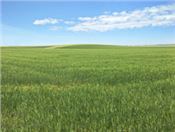|
Soft Durum Wheat Opens Door To Expand Food Uses

Soft Svevo durum wheat growing in an Idaho field.
BELTSVILLE, MD.
Soft Svevo, a new soft durum wheat variety developed by Agricultural Research Service (ARS) scientists and their collaborators, could expand the market for wheat.
Traditional durum wheats are primarily grown as a source of semolina – a coarse meal used to make pasta, couscous and other products. However, producing semolina requires specialized mills that can grind durum wheat's rock-hard kernels. This, in turn, has limited the food uses for durum wheat, which comprises 3 to 5 percent of the total U.S. wheat crop.
Craig Morris, an ARS chemist in Pullman, Washington, has a soft spot for durum which, despite the hard nature of its kernels, is better adapted to hot, arid growing regions of the United States than the more commonly grown bread wheat varieties. Over the past 20 years, he and colleagues have delved into the genetics of wheat kernel development for clues that could broaden the number of products made from durum.
Along the way, the team determined that durum's hard kernel texture has no relationship to pasta quality. Rather, it is durum's yellow kernel color and high-protein content that gives pasta its desirable firmness. Additionally, these features have nothing to do with the particle size of semolina made from the kernels, according to Morris.
Based on that premise, the researchers set out to create a soft durum wheat with kernels easily milled into a fine flour instead of semolina. Finding two genes that control kernel texture in soft bread wheats – Puroindoline a (Pina) and Puroindoline b (Pinb) – proved a breakthrough. The team moved these genes into a prized Italian durum variety to eventually produce Soft Svevo, marking the first soft durum of its kind.
Tests show Soft Svevo's flour is similar to soft bread wheat flour. According to Morris, it imparts an appealing aroma, flavor and color to pizza crusts, baguettes and other baked goods. ∆
|
|